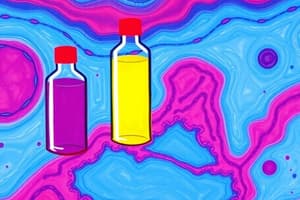Podcast
Questions and Answers
What is fixation?
What is fixation?
The stabilization of protein in biological tissues.
Which of the following is a function of fixatives? (Select all that apply)
Which of the following is a function of fixatives? (Select all that apply)
- Enhance tissue decay
- Facilitate staining of tissues (correct)
- Increase visibility of tissues (correct)
- Prevent autolysis (correct)
Fixation is a process that allows tissues to decay.
Fixation is a process that allows tissues to decay.
False (B)
Fixation terminates any ongoing biochemical reactions and increases the mechanical strength or stability of the treated ______.
Fixation terminates any ongoing biochemical reactions and increases the mechanical strength or stability of the treated ______.
What are additive fixatives?
What are additive fixatives?
What is one effect of nonadditive fixatives?
What is one effect of nonadditive fixatives?
Temperature does not affect tissue morphology during fixation.
Temperature does not affect tissue morphology during fixation.
What is the universally used fixative?
What is the universally used fixative?
Adequate fixation is needed for ______ preservation.
Adequate fixation is needed for ______ preservation.
What is the purpose of fixation?
What is the purpose of fixation?
Flashcards are hidden until you start studying
Study Notes
Fixation Definition and Function
- Fixation stabilizes proteins in biological tissues, preventing decay through autolysis (self-digestion) or putrefaction (bacterial decomposition).
- Fixatives are chemicals that halt biochemical reactions and increase tissue strength.
- Fixatives kill tissue, preventing autolysis and putrefaction.
- Fixatives maintain the relationship between cells and extracellular substances (e.g., collagen, reticulin, elastin).
- Fixatives enhance tissue visibility by altering refractive indexes.
- Fixation preserves biological samples as close to their natural state as possible for examination.
Aims of Fixation
- Prevent postmortem degeneration and autolysis.
- Counteract hydrolytic enzymes.
- Inhibit bacterial effects.
- Harden tissues by protein coagulation.
- Act as a mordant, improving tissue staining.
Actions of Fixatives
- Fixatives increase tissue receptiveness to dyes, often acting as mordants to link dye to tissue.
- Each fixative creates a unique morphological pattern and potential artifacts in nuclear chromatin, cell membranes, and staining intensity.
- Physical fixation methods include heat (e.g., microwave) and desiccation (air drying), though these are less common.
Types of Fixatives
- Additive fixatives: Chemically bind to tissue, altering its structure. Examples include mercuric chloride, chromium trioxide, picric acid, formaldehyde, glutaraldehyde, glyoxal, osmium tetroxide, and zinc salts.
- Nonadditive fixatives: Act on tissue without chemical binding, usually by dissociating water molecules from proteins. This can cause shrinkage and hardening. Examples include acetone and alcohols.
- Coagulant fixatives: Form a network within tissue, improving solution penetration. Examples include zinc salts, mercuric chloride, cupric sulfate, ethyl alcohol, methyl alcohol, acetone, and picric acid (acetic acid is a coagulant for nucleic acids, but not cytoplasm).
- Noncoagulant fixatives: Create a gel-like structure, hindering subsequent solution penetration. Examples include formaldehyde, glutaraldehyde, glyoxal, osmium tetroxide, potassium dichromate, and acetic acid.
Factors Affecting Fixation
- Temperature: Affects tissue morphology.
- Tissue Size: Thickness is crucial; ideally no more than 3mm thick to ensure reagent penetration.
- Volume Ratio: Fixative volume should be 15-20 times greater than the tissue volume.
- Time: Immediate placement in fixative is vital. Adequate fixation time (e.g., 6-8 hours for formalin, depending on tissue size) is necessary for morphology preservation and to prevent distortion during subsequent processing.
Choice of Fixative
- 10% formalin is a commonly used fixative.
- Specialized studies may require different fixatives.
Studying That Suits You
Use AI to generate personalized quizzes and flashcards to suit your learning preferences.




